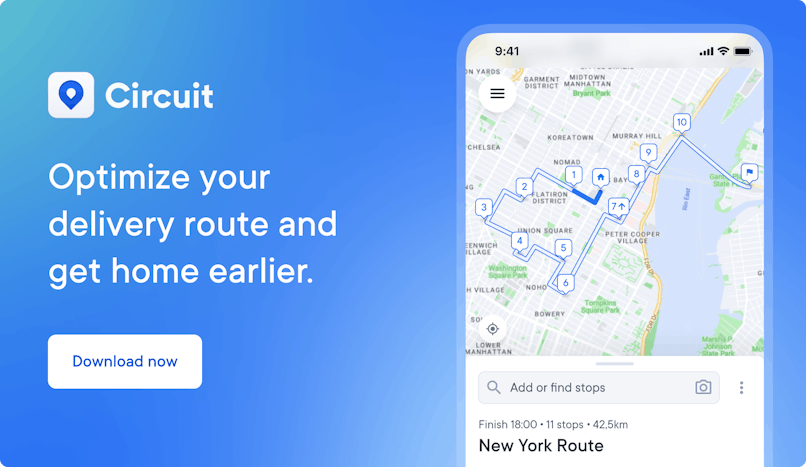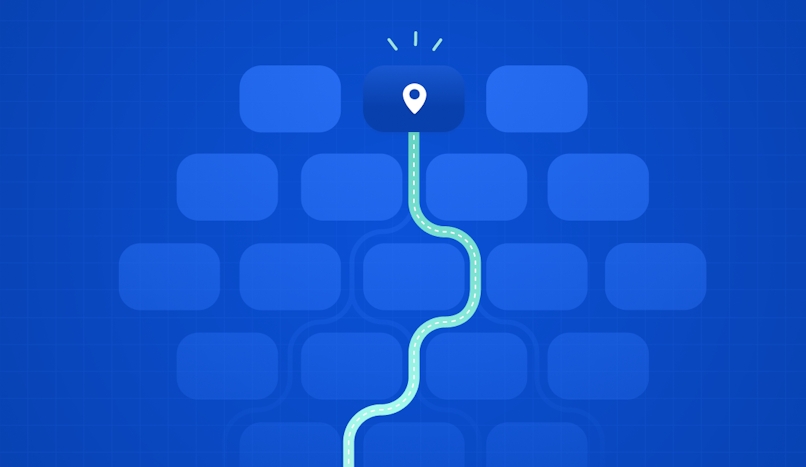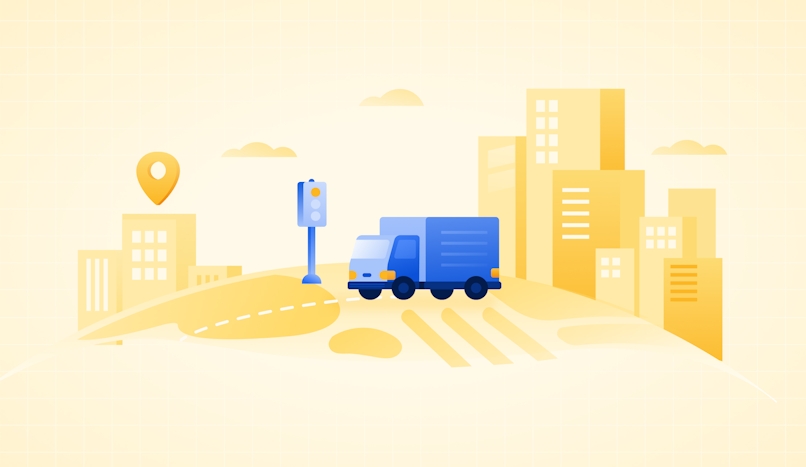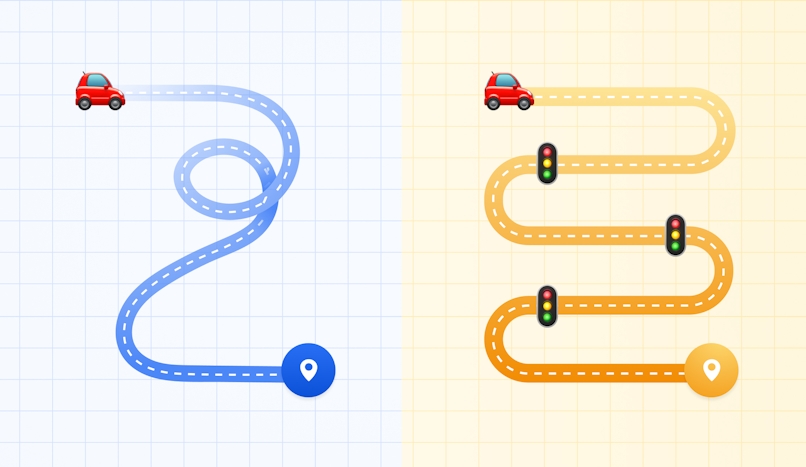Dynamic vs. Static Route Planning
Understanding the difference between dynamic and static route planning is essential to your job as a delivery driver. We explain it here.

No matter which routing method you use, Circuit Route Planner can help you save time and earn more money with optimized routes.
Whether you’re a FedEx driver who makes routine rounds to local businesses or you’re an Instacart delivery driver taking orders by the hour, your route is a pretty big deal.
You can waste a lot of time, money, and opportunity by using the wrong route planning method.
No one wants to get stuck in traffic and piss off customers because their deliveries are late.
That’s bad for business and bad for your wallet.
But if you plan delivery routes the right way, you can shorten your routes, reduce the time you spend completing each stop, and make your customers as happy as possible — all of which can mean more money.
One of the biggest things last-mile delivery drivers should know about route planning is the difference between static route planning and dynamic route planning.
If you’re wondering which routing method to use as a new delivery driver, or you’ve been driving for a while and are looking for ways to make bigger bucks, I’ve got you covered.
Below, I talk about both route planning methods, including the pros and cons of each type, and how you can decide which is right for you.


What is dynamic route planning?
The great thing about being a delivery driver is that every day is different. But that also means your routes might not be the same.
That’s where dynamic route optimization comes in.
With the help of route optimization software like Circuit Route Planner, dynamic route planning is the process of creating a unique route depending on your orders for the day.
Basically, you start each workday with an optimized route — but that route can also change based on real-time data, like traffic conditions and road construction.
And if you’ve got priority packages, dynamic route planning will make sure you get to those stops first.
So, you can spend less time dealing with traffic cones and more time getting shit done.
There are two phases of dynamic routing.
Phase 1: New routes
You’ve got your list of stops for the day, but now what?
Route planning software automatically comes up with the best route for you using a fancy-schmancy algorithm.
It’s pretty cool.
The Circuit Route Planner app, for example, takes a list of stops you enter and then reorders those stops based on a whole bunch of things to come up with the most efficient route possible.
It does this in a matter of seconds.
But that’s not all. *drum roll*
Circuit works with your favorite GPS technology so that real-time weather, traffic conditions, and construction zones don’t come as a surprise during your route.
Here’s an example of when a DoorDash driver suddenly had to tango with a closed road that his routing app didn’t warn him about.
The street right outside my house was totally closed off a couple of weeks ago because a construction crew was doing slurry work on it.
No parking or driving was allowed.
I parked my minivan down the block the night before to make sure I could take my kids to school in the morning.
No big thang…
But then, my husband and I ordered lunch through DoorDash.
And we forgot until our driver was only minutes away that, oh yeah, the street is closed. Oops!
My husband grabbed his phone and called our driver ASAP and asked him if he could meet us down at the corner.
“Um, what’s the name of that street? Is it Daisy? Yeah, it’s the corner of Daisy and Cherokee, I think. Can you meet me there?”
Our wonderful driver was clearly surprised but agreed to follow our vague directions. My husband went down to meet him and grabbed our order.
Crisis averted. Whew!
Now, this all worked out fine, yes, but if our DoorDash driver had been using an app that routes around real-time construction zones, he could have actually planned how he was going to deal with our closed street.
It would have made the whole delivery less chaotic and stressful.
That’s what’s so great about using a routing app like Circuit. With just a few taps, you can get the best real-time route that avoids obstacles in the first place.
But dynamic routing doesn’t end with just creating an optimized route.
Phase 2: Ongoing route optimization
Now that you’ve hit the road, is it too late to change the route?
Not at all!
After you create a route, a dynamic route planner will keep optimizing the route as you drive throughout the day.
Circuit works with GPS apps, like Waze or Google Maps. The Circuit app shows a picture-in-picture screen laid over the GPS screen.
It works really smoothly so that you can see your turn-by-turn GPS navigation at the same time as you manage your route info.
It’s awesome!
With Circuit, you can also add or delete stops even after you’ve already started your route.
Add a stop, for example, if you get an emergency request and need to pop that stop into your route as a priority.
Like, if you’re already on your way to deliver an Instacart order and your customer offers you an extra fat tip to pick up something they forgot, you could hit up a nearby 7-Eleven to grab that bonus prize.
Or add a bathroom stop!
Any time nature calls when you’re driving your route, use the Flush app to find the closest public restroom.
Then, enter that address into Circuit as your next stop, so you can get there before nature stops calling and starts busting through the door.
That’s dynamic routing at the driver level.
Pros and cons of dynamic route planning
Dynamic route planning can be a great way to create more efficient routes, but there are also a few downsides to be aware of.
Here are the main pros and cons of dynamic route planning for delivery drivers.
Pros of dynamic routing
- Saves time driving from stop to stop: Dynamic routing software figures out the fastest route possible, so you can save time, complete more deliveries on time, and make more money!
- Reduces fuel costs and vehicle maintenance: With a dynamic route that minimizes your time driving from stop to stop, you’ll use less gas and put less mileage on the vehicle, so you can spend less money on transportation and keep more cash in your bank account.
- Allows more accurate ETAs for customers: Dynamic routing software uses real-time data to create optimized routes, so you can give your customers super-accurate ETAs for their deliveries.
- Minimizes delivery disruptions and disappointed customers: By using dynamic routing when unexpected obstacles come up, like a closed road or a car accident, you can quickly reroute and avoid major delays. That helps you keep customers happy with on-time deliveries.
- Takes care of priority deliveries: Dynamic routing allows you to make changes to your route on the fly. So, if you get a priority order right before you’re about to head out in your delivery truck, you can quickly add that stop into your route, hit the reoptimize button, and be on your way.
Cons of dynamic routing
- Hard to do by hand: If you’re not a big fan of technology, the routing app required to use dynamic routes might not be your favorite tool in your delivery vehicle.
- Premium apps aren’t usually free: If you’ve got only a few stops during the day, you can use a lot of routing software, like Circuit, for free, which is awesome. But if your delivery route starts to outgrow the free plan, you’ll have to pony up some change to upgrade to premium services.
- Can’t load your delivery vehicle until new routes are created: When you create dynamic routes, you’ll have to wait to pack your vehicle every morning until your new delivery schedule is available.

What is static route planning?
Static route planning is used by delivery drivers to create long-term routes that generally stay the same from day to day or week to week.
If you have regular customers who are used to seeing your smiling face at the same time, every time, you’re a static route driver.
Static routes are usually made only once or twice a year (maybe quarterly) or only when you need to change something, which is rare.
If you have a regular customer base, and then you win a contract with a new customer, that would be the time to create an updated static route.
Or, if you lose a customer, you’ll need to delete that stop from your route.
The rest of the time, you’ll just go on about your business, driving your static route every day, getting to know your delivery area and your customers.
Before software was invented to churn out optimized dynamic routes in only seconds, static routing was the standard routing method.
Drivers made static routes by hand and accepted this as the best option we had.
Today, some delivery drivers still only need static route planning because of their type of business, but others could totally make more money by upgrading to dynamic routing or hybrid routing. Those deets are down below.
Pros and cons of static route planning
Static route planning may seem like the best way to make your delivery route, but you’re still probably missing out on some of the key benefits of a dynamic routing app.
Check out these pros and cons of static route planning to see what I mean.
Pros of static routing
- Can be done by hand if needed: You don’t need a computer or fancy routing software to create a static route. With a list of your regular stops, and a pen and paper, you can write up a static route for your routine deliveries.
- Learn your route’s usual traffic patterns: If you’re driving the same route to the same stops all the time, you’ll naturally get to know the area and get better at your job, so you can save time and make more money.
- Can load your vehicle in advance: When you already know which stops you’re visiting the day before, you can load up your delivery vehicle way before heading out on your delivery route.
- Less expensive than dynamic routing software: Because static routing doesn’t require much computing power and can even be done by hand, you don’t need to spend any money to do it.
Cons of static routing
- Could result in large time windows or unreliable ETAs: Your regular customers will learn to expect you during their regular time windows, but because your route doesn’t adjust dynamically for real-time traffic, weather conditions, and other unpredictable delays, you can’t give them more precise ETAs for their deliveries the way you could with dynamic routing.
- Hard to make last-minute changes: Emergency delivery requests and priority orders, especially same-day deliveries, are really hard to manage if you use a static route. When is the best time to fit it in? Or do you even have time for it at all? Those questions are definitely easier to answer with dynamic routing.

Key differences: dynamic routing vs. static routing
Here’s a quick breakdown of the main differences between dynamic and static route planning for delivery drivers.
Why would you choose static routing over dynamic routing?
Static routing definitely has its place.
And you don’t want to jump right into dynamic routing just because it sounds like the more advanced option.
I’ll share a story about my dad, who used to own a franchise business driving a Mac Tools truck and selling tools to auto repair professionals at companies around town.
He drove to the same auto dealerships and auto repair shops each week.
He knew his regular customers, and they knew when to expect him.
That meant he relied on a static route for his daily business, whether he was delivering a custom order or just making the rounds to sell tools off the truck.
This was back in the day around 2005 before the iPhone existed, and there weren’t route planning apps to rely on.
MapQuest was the hot navigation tool of the time, and you still had to print out your directions before heading out on the road.
(I’m aging myself.)
But my dad didn’t need that tech anyway because his type of business relied on the same customers every day and every week.
So, he just knew his route, and he knew the area.
If there was a road closure or a priority delivery, he pretty much managed all of that up in the old noggin.
This is a basic, seriously low-tech example of static route planning.
And even today, this would work for a mobile tool distributor who has a limited number of stops in their route.
They might benefit from route optimization, yes, but the basic planning method — static versus dynamic — should probably stay static in that field of business.
Or maybe even consider a hybrid approach (we go into details below).
Static routing is good for drivers who visit the same customers at around the same time each week.
Hybrid routing: Get the best of both worlds
Now that you can keep crazy-efficient routing apps right in your pocket, even delivery drivers who mainly use static routes can benefit from some of the features of dynamic routing.
Static routing plus dynamic routing could be just what you need to up your delivery game and earn more cash.
So, slap ‘em together, and you get a hybrid routing plan that kicks the wind out of old dinosaur static routing methods.
Hybrid routing basically starts with your fixed static route every day.
Then, you can use your dynamic routing app, like the Circuit Route Planner, to optimize your route for that specific day based on your customers' location and real-time conditions.
For example, if smartphones had existed when my dad was a Mac Tools truck driver, he could have relied on his usual route.
But if a priority order came in and an auto technician needed a tool first thing in the morning, then maybe my dad could have benefited from a routing app.
Instead of driving to his priority customer in the afternoon like he usually might do on his fixed daily route, my dad could use the Circuit app to enter that stop as his first priority for just that day.
It would only push back his other stops a little more into their expected delivery windows.
Delivery drivers of all kinds can use hybrid routing the same way — start each day with your static route, and use the app every morning to optimize for up-to-date conditions.
You’ll be able to offer a better customer experience, save time and gas, and make better money.
The United States Postal Service (USPS) already uses a form of hybrid routing for its thousands of mail carriers.
I mean, I see the same USPS driver delivering my mail to the community mailbox around the same time window every day.
Obviously, their route is somewhat predictable and fixed.
But the USPS ain’t no slouch when it comes to taking advantage of the latest technologies available.
In addition to static routing, USPS dispatchers and drivers also use advanced dynamic routing and optimization to make sure the huge government postal service keeps up with its mail-delivering duties.
Neither rain, nor snow, nor sleet, nor hail can stop it.
Sunday and holiday deliveries, for example, got a lot easier for USPS to handle after they adopted new dynamic routing technology in 2013.
The next time USPS delivers a package to you on a Sunday, you’ll know that weekend magic was made possible by dynamic routing technology. Woot!
By using both static and dynamic routing, mobile tool salespeople, newspaper delivery drivers, and other fixed-route drivers can all benefit by saving time and making customers happier, which adds up to more money in your pocket, right alongside that sweet, money-maker routing app.
How does dynamic routing software work?
Dynamic routing software uses an advanced algorithm to come up with optimized driving routes in just seconds.
The Circuit Route Planner app, for example, is so easy to use that all you do to get started is download the app (made for iOS and Android), enter all of the stops for your route, choose your settings, and then create your optimized route.
The app lets you set priority versus normal settings for each stop or expected time windows.
You can also set an average time for each stop.
Circuit even lets you choose a preferred side of the road or choose to deliver to both sides of the road, depending on your vehicle and needs.
As soon as you hit the optimize button for your list of stops, Circuit’s algorithm quickly simulates thousands of different routes to find out which sequence of stops is the most efficient.
Within seconds, the app will give you that optimized route.
Once you have your optimized route, Circuit will prompt you to open your GPS navigation app — and the two will work together to help you throughout your day.
Circuit can be used for both static and dynamic routing.
For example, if you use the same master route every day (static), it’s super easy to duplicate a previously used route in Circuit and then optimize it for your new day (dynamic).
And any time you need to add or delete a stop from your route in progress, you can do it with just a few taps in the app and then receive a reoptimized route to continue on your way.
For more ideas about how you can optimize your dynamic routes, check out our post on the five ways to find the best delivery route, even at peak times.
What’s the best dynamic route optimization software for drivers?
Whether you need a strictly dynamic routing tool or you’re looking for a hybrid routing solution, Circuit Route Planner is the best app to start with.
The way you plan routes for your daily deliveries plays a big role in how quickly you get from stop to stop, how happy you make your customers, and how much you’ve actually made ($$) by the end of each day.
With Circuit, you’ll get peace of mind knowing your delivery routes are being optimized to help you make the most money day after day.
Circuit is a simple routing app that any driver can quickly learn and use.
Plus, the app also helps you as a driver with cool features like a package finder, proof of delivery, and more.




